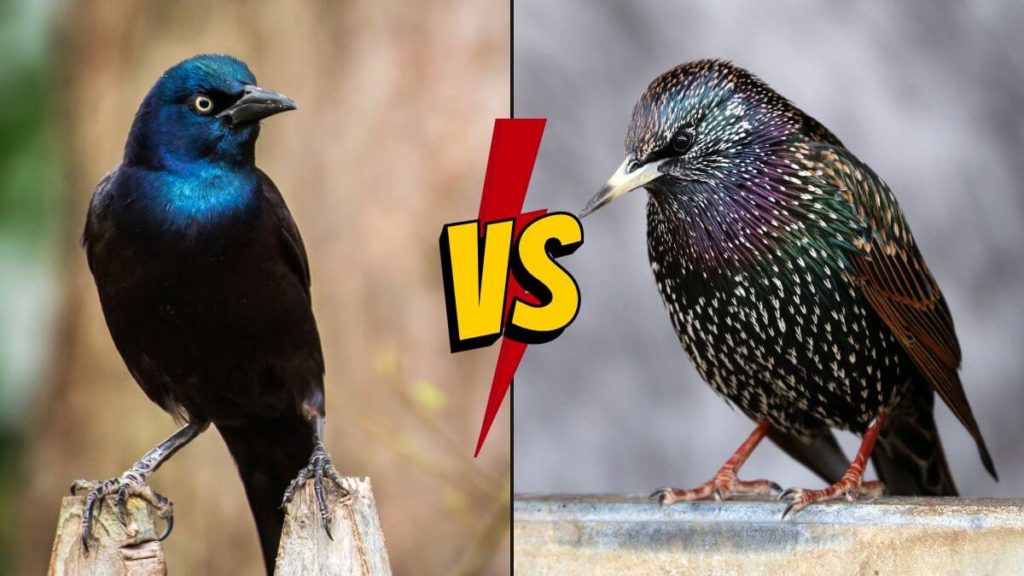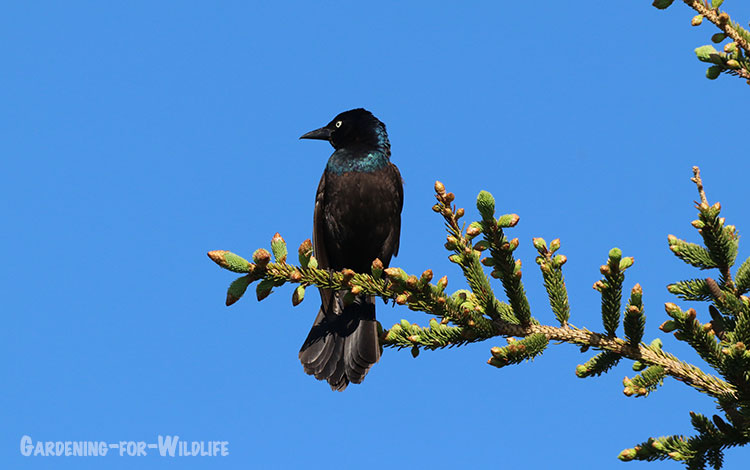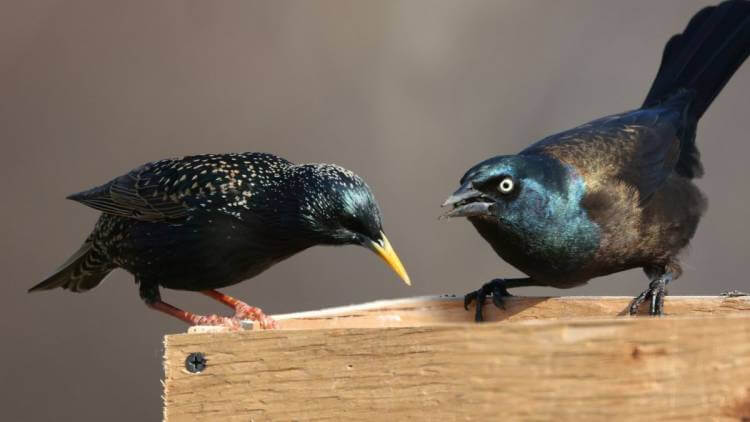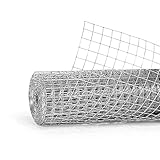
I’m often asked about the groups of black birds that can be bullies at bird feeders. In almost all cases, we are talking about grackles vs starlings, or Common Grackles and European Starlings to be precise.
While these birds do flock together, it can be fairly easy to pick them apart. Starlings have dark eyes and pink feet. Grackles a yellow ring around the eyes and black feet.
By learning more about each type of bird you can learn how to encourage, or discourage, them around your bird feeders, depending on your preference.
Grackles 101
In the genus Quiscalus there are 11 different species of grackle. The Common Grackle is, well, common in most areas. A group of grackles is not referred to as a flock but a plague. Those of us who have parked our car under the wrong tree or power line feel a great deal of truth in that term.
What do Grackles Look Like?
Grackles are mid-sized birds that have iridescent shades of blue on black feathers. They have long bills with a slight downward curve and a bright yellow ring around the eyes. While Common Grackles are large birds, if you are looking at a Great-tailed or Boat-tailed Grackle, you will usually know it because these two types are larger. As their names suggest, they also have longer, more prominent tails than the Common Grackle that appear flattened vertically or keeled.

As in many bird species, male Common Grackles are larger than the females and are sexually dimorphic, though it is not as pronounced as in their relatives the Great-tailed and Boat-tailed Grackles. While the male Common Grackle looks black from a distance, in the right light I’m always amazed to see the black changeover to iridescent shades of blue on the head and olive to bronze on the body.
The slightly smaller female has a shorter tail and is less glossy or iridescent, appearing brown all over.
Their bills are long and stout and have a slight downward curve. The strong bill is essential for them to be able to crack their most sought-after food, seeds. Here is where they earn their nickname as bullies around feeders, nudging out other birds on the ground for the scraps.
What do Grackles Eat?
Seeds aren’t the only thing they will eat, though. Grackles are opportunistic birds that will also go for a variety of insects and even fish, frogs, and other birds. Yes, birds. Common Grackles are one of several bird species that will go after birds’ eggs and nestlings, and even sometimes other adult birds such as House Sparrows. It’s a tough world out there and everyone needs to eat.
At this point, a lot of you may not be on Team Grackle for these reasons. Here is your curve ball. Common Grackles, as a native species to North and South America, are considered to be in steep decline. Over the past several decades they have lost 2% of their population each year, or more than 54% since the 1960s. While they may not be the most welcome guest at your backyard feeders, it is important to keep this in mind.
European Starlings 101
Frequently seen foraging on the ground around Grackles are Starlings, more accurately known as the European Starling. As the name suggests, this is not a native bird to North America which is a big difference between it and Grackles. All Starlings in the New World are descended from an original 100 birds released over a two-year period in 1890 and 1891 into New York’s Central Park.
Why, you ask? It is well documented that a Shakespeare enthusiast (yes, you read that right) wanted to honor his favorite playwright by introducing into North America every bird Shakespeare ever mentioned in his works.
That Shakespeare reference was just one mention in Henry IV yet quite notable. In the play a soldier wants to teach a starling to repeat the name a King never wants to hear again, and then gift the bird to him so it can repeat the name over and over. The mention celebrates the fact that Starlings are great mimics known to learn and repeat the calls of up to 20 different birds and even urban and human sounds.
European Starlings have gone on to expand across the continent from Alaska to the Canadian Maritimes to the north and south to Mexico, the Bahamas and part of Cuba. Typical with non-native species, European Starlings do cause their fair share of problems.
Starlings are opportunists which is characteristic of many animals, native or non-native, that can live in many places and are not affected by, in fact benefit from, habitat changes and city expansion. One of the biggest concerns in their competitive ways is nest cavity take over, crowding out blue birds, flycatchers, woodpeckers, and many other native species.
What do European Starlings Look Like?
Starlings are black, stocky birds with short tails and long, slender beaks. In the fall, when starlings are growing new feathers, those feathers have white tips with the rest of the feather being brown-black and iridescent. This gives them a rather spotted appearance.
However, by the time breeding season comes around, the white tips are worn away giving the birds an allover glossy black appearance with some iridescence. Males also have color-changing beaks in the breeding season, going from black in fall and winter to yellow.
What do Starlings Eat?

Starlings’ preferred food is insects such as flies, caterpillars, spiders, and earthworms. They will also compete with native species for food and will come to bird feeders.
Do Starlings and Grackles Flock Together?
Starlings can be seen flocking together up in trees or on wires as do grackles, though they tend to mostly be in groups of their own kind up high. While starlings and grackles are both quite gregarious, grackles become territorial during the breeding season against any other birds. Starlings also tend to be in larger flocks outside of breeding season.
However, in the spring and summer I will often see these two birds sharing space around and below bird feeders, as well as open grassy areas such as parks and neighborhood lawns.
While starlings are using their sharp, long beak to probe the ground for soil insects and other invertebrates, grackles are going for primarily seeds whether it is under feeders or in open areas. Joining both these birds in my lawn are also pigeons, robins, and sparrows.
How Do You Keep Starlings and Grackles Away from Bird Feeders?
You can keep these birds away from the bird food intended for other species by choosing the right bird feeder and using bird feeder cages and guards.
Choosing the Right Feeders
The style of bird feeder you use can be the first step in discouraging grackles and starlings and encouraging the types of birds you do want. Domes above bird feeders, popular to discourage squirrels from getting to seed also seem to discourage starlings from approaching a feeder.
There are dome feeders on the market in which the dome can be adjusted to sit at different heights above the seed tray. By lowering the dome and making the space tighter, larger birds will be discouraged.
This dome birdfeeder may help keep starlings and grackles away:
- ADJUSTABLE: Protective dome is height adjustable to selectively screen out certain sizes of birds. Leave the cover open to invite all birds in or slide it down to exclude larger birds
- SPECIFICATIONS: Dome cover is 10-inches in diameter. Platform tray holds up to 1 pound of bird feed
Starlings are not the most agile flyers and do not seem to be comfortable flying up under things such as domes. Tube feeders with small, short perches can “size-out” birds like grackles that find them hard to use. Even starlings find tube feeders difficult to use.
- CAPACITY: Tube bird feeder holds up to 1 pound of birdseed; 6 feeding ports
- EASY CLEANING: Ring Pull Advantage for easy disassembly with no tools required
- {FOUR FEEDING PORTS}: Four well-spaced feeding ports with perches allows for multiple birds to feed simultaneously. Fit for Mix Seeds. This Bird feeders for outdoor hanging is one of the most widely used feeder type and suitable for most types of seed and seed mixes, blends, sunflower seeds to attract birds including great spotted woodpeckers, house sparrows, goldfinch, the siskins Dunnock, bullfinch, blue tit, greenfinches, nuthatches and pied fly catchers.
- {METAL BIRD FEEDER}: Metal feeding ports, lid and base are chew-proof, preventing Squirrel Damaging. Powder Coated Metal makes the feeder rust-proof and weather resistant. Extra thick plastic tube is healthier for birds and harder for squirrels to damage.
While starlings prefer insects, they do love the suet I put out. I recently discovered a suet feeder that holds the suet horizontally under a protective “roof” instead of vertically. This requires any bird wanting the tasty treat to fly up underneath it and hang on the holder wire.
- Upside-down design naturally eliminates nuisance birds like blackbirds and grackles that are not comfortable hanging upside-down to eat
- Made from premium cedar
- PRODUCT SPECIFICATIONS: Includes 1 Cake Suet Feeder | Material: Recycled Poly-Lumber | Color: Taupe w/ Green Roof | Measurement & Capacity: "7”L x 6-1/4”W x 4-1/4”H, w/hanging cable 12”H
- UPSIDE DOWN SUET FEEDER: This type of feeder dispenses a high-energy suet food cake made from rendered animal fat. Holds up to [1] suet cake
While nuthatches, woodpeckers, wrens, chickadees, and titmice are non-plussed by being required to land and eat upside down, both starlings and grackles are nots fans of this technique. While they may not try it, this has discouraged them and allows other birds to have their chance at the suet.
Bird Feeder Cages and Guards
A cage or guard around your feeder is another option. The strategy with a guard is that the wire grid is sized so smaller birds can get through it to access the feeder while larger birds such as grackles and blue jays cannot.
Guards a bonus of keeping squirrels away from the seed, even though they may still try and hang on the cage. There are many feeders on the market that already have a guard attached. For feeders you already have, try using hardware cloth or fencing material that have openings in the wire of 2” x 2” to build a cage that will encircle your feeder.
- ✔ Super Sturdy construction - Made of 10 gauge heavy duty galvanized wire, galvanized before welding providing a double coating for maximum rust resistance, Class 1 galvanized zinc coating for long-life, the galvanized welded wire would be a good choice for everyone
- ✔ Suitable size - Strong 10 gauge hardware cloth provides optimal strength, the wire mesh with 2” x 2” square opening measures 48 inch width by 50 ft length. Home and garden uses, animal enclosures, you can tailor it to your specific needs. The holes are 2” x 2” to keep animals out and the chickens / rabbit safe, protect your garden fruits and vegetables from rodent animals.
You will also want to make sure the cage tapers or closes toward the top and bottom so your feeder can only be accessed through the grid. Unfortunately, starlings are usually able to get through the cages since they are smaller birds, though their lack of agility combined with a tube feeder waiting inside the cage may encourage them to move on.
In the vein of “mechanical” means, a la styles of feeders to discourage these birds, you can also use a tray or seed catcher below your bird feeder. Birds are messy eaters and will throw out seeds from the feeder in the process of grabbing what they want and even searching for the tastiest options in a seed mix.
The seed that ends up on the ground provides an easier option for grackles and may also attract insects in the soil and grass that, in turn, attracts starlings. By affixing a shallow, wide tray below your bird feeder to catch what birds throw out, less is available on the ground. You could also place a deep bin underneath the feeder as most birds may be reluctant to fly into a dark, deep bin.
How Do You Get Rid of Grackles and Starlings?
I’m going to be honest and give you an answer you may not want to hear. Nothing will guarantee that you won’t see these birds in your yard. In addition to the type of feeders and mechanical strategies I’ve employed in my yard, it also comes down to the type of food I provide.
Often referred to as thistle seed, Nyjer, a small, black seed from a type of plant unrelated to thistle plants, is popular with songbirds. Grackles are not interested in this seed and while starlings will eat it, they prefer sunflower seeds and were not as willing to compete with other birds for it.
Try to choose foods for birds that are not mixes. Other foods starlings don’t want are peanuts in the shell and safflower seeds. Avoid mixes that contain sunflower seeds, as both starlings and grackles do like them.

Grackles aren’t usually a long-term problem as their habit is to visit for a short window of time and then continue to move in search of additional food sources. I sometimes remove my feeders for a short period of time. This gives me time to clean them and refill them, and in that time the flocks of grackles and starlings hopefully move on, at least for a little bit.
Ultimately, the best strategy I find is a balanced approach. I hang feeders that discourage large birds and fill them with Nyjer seed for the songbirds. I sometimes also put out a domed feeder with a mix of safflower seeds and Nyjer.
To discourage grackles and starlings from still attempting to access, bully and outcompete the smaller songbirds, on the other side of my yard I hang feeders that are a bit more accommodating to them. I’m not trying to attract them but assume that if they have an easier option in the yard, they will go there and leave the other feeders alone.
Grackles vs Starlings Summary
Grackles and starlings have a similar appearance to the novice birder, but with a close look you can find the distinguishing features that set them apart. Combined with knowing their basic patterns and behaviors, you’ll soon be able to identify the two species for other birders.
Both birds are known to bully other birds and may push away the species birders are hoping to attract. However, with the right bird feeder and food choices, it is possible to at least discourage grackles and starlings from entering your yard.
Do you have birding advice to share on these two species of birds? Please share in the comments section.






